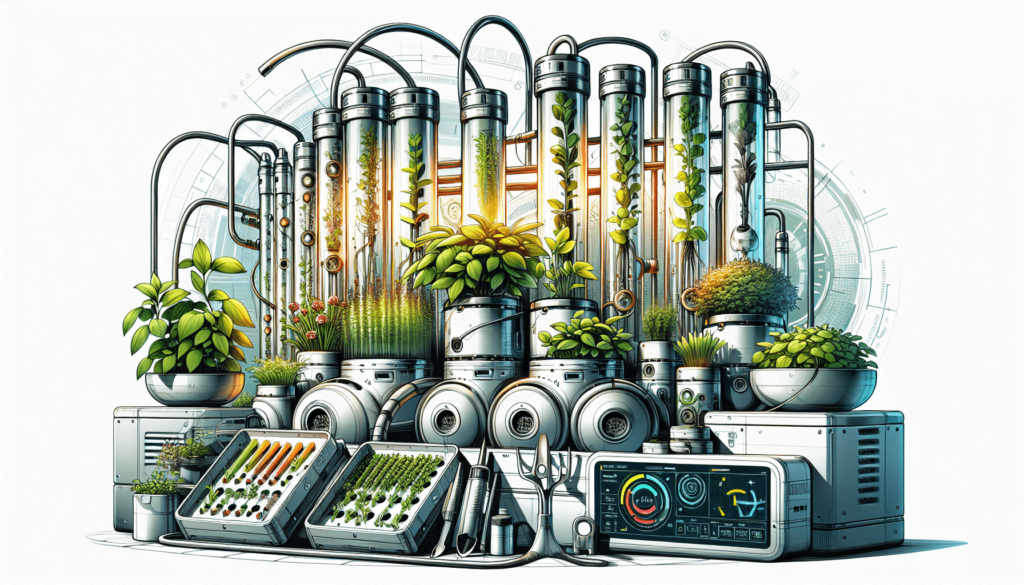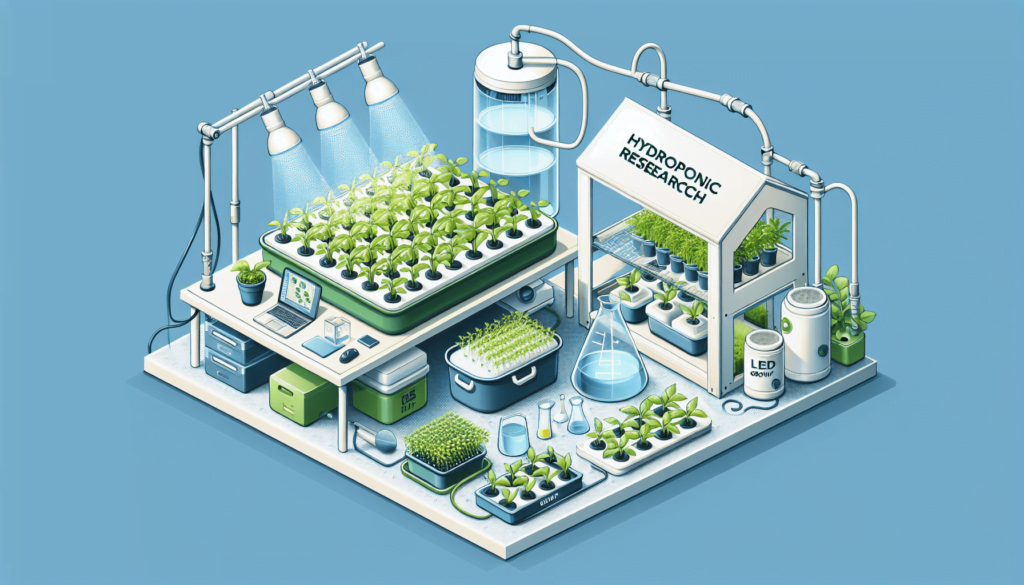With the rise of urban farming and sustainability, the world is seeing a revolution in how we cultivate our own produce, right from the comfort of home. This is particularly apparent in the field of home hydroponic systems, which have seen numerous incredible innovations as of late. From systems that save water, to those that maximize plant growth, to solutions that automate the entire process – this article shines light on what’s fresh and new in the field. So, join us in this exploration of the latest trends and advancements that are transforming home hydroponics into a fascinating new frontier in sustainable living.
Understanding Hydroponics
We’re so glad you decided to join us on this learning journey! In this section, we’ll take a deep dive to understand hydroponics – what it is, its historical background, and the advantages and disadvantages of this innovative farming technique.
Definition of hydroponics
Let’s start with the basics. Hydroponics is a method of growing plants, but instead of using traditional soil, we use water. The term derives from the Greek words ‘hydro’ meaning water and ‘ponos’ meaning labor. The nurturing fluids ideally blend all the necessary nutrients plants need, providing an enriched environment for our green friends to thrive.
Historical background of hydroponic systems
Believe it or not, the idea of hydroponics has been around for a long time. The infamous Hanging Gardens of Babylon, one of the Seven Wonders of the Ancient World, are believed to have used an early form of hydroponics. Their impressive development advanced throughout cultures and centuries. During the 19th century, researchers began to decode the basics of plant nutrition, which provided the theoretical backbone for what we now know as hydroponics.
Advantages and disadvantages of hydroponics
Like any system, hydroponics has its pros and cons. On the positive side, hydroponics allows for precise control over the growing environment. It also uses water more efficiently than traditional agriculture and can be set up almost anywhere! However, hydroponics systems can be expensive to set up and require careful monitoring to prevent system failures. Despite the disadvantages, the benefits often outweigh the challenges, especially when suitable practices are followed.
Types of Hydroponic Systems
Hydroponics might seem pretty linear, but there’s actually a significant amount of diversity within this field. Let’s take a look at a few key variations.
Wick system
The wick system is the simplest type of hydroponic system. It’s a passive system, meaning there are no moving parts. The nutrient solution is drawn into the growing medium from the reservoir with a wick.
Water Culture system
A water culture system is one of the simplest active hydroponic setups we have. In this system, plants are held above a reservoir filled with nutrient-rich water and aeration is provided through air stones.
Aeroponic system
Aeroponics is considered the most high-tech type of hydroponic gardening. The plants hang in air and are misted with the nutrient solution. This system provides a high oxygen level in the root zone – perfect for plants’ development.
Nutrient Film Technique (NFT) system
In a Nutrient Film Technique system, the plants are grown in shallow troughs, and a thin film of water containing all the dissolved nutrients required for plant growth is circulated past the bare roots of plants.
Ebb and Flow (Flood and Drain) system
In an Ebb and Flow system, plants are placed in a tray separate from the nutrient-rich solution, and the solution is periodically flooded, allowing the plants to take up their nutrients, before it’s drained away again.
Drip system
Finally, a drip system, or trickle system is essentially sophisticated watering in which the water is dripped onto the plants from above, making not only water but also the nutrients directly available to the plants.

Key Components of Home Hydroponic Systems
What’s involved in a home hydroponic system? Let’s explore some of the parts required.
Reservoir
First and foremost, a reservoir is needed to hold the nutrient solution. This device can range from a small tank to a large, full-scale system.
Grow Light
Grow lights are essential in providing our plants with the kind of light they need to photosynthesize and grow. This could either be natural sunlight or a light source that mimics the sun’s natural rays.
Air stones and air pump
Air stones and pumps are used to provide oxygen to the root zone of our plants. When roots get more oxygen, they can absorb more nutrients, which leads to improved growth rates.
Growing medium
Rather than soil, hydroponic systems employ different forms of growing media to provide plant roots with physical support. Choices include Rockwool, perlite, vermiculite, and clay pebbles among others.
Nutrient solution
The nutrient solution is the lifeblood of hydroponics. It’s a carefully balanced, water-soluble solution packed full of all the macro and micronutrients that plants need to grow.
pH control
Maintaining the correct pH level in your nutrient solution is essential for plants to be able to take up necessary nutrients. pH adjusters are simple additives that increase or decrease pH levels.
Integration of Automation in Hydroponic Systems
Let’s look at how hydroponics can incorporate automation to ensure optimal conditions are maintained with less manual input.
Automatic watering systems
One critical aspect of hydroponics is watering, and this can be automated with pump-driven systems that spray, mist, or drip water onto your plants at preset intervals.
Light timers
Light is, of course, essential for plant growth. Automation in hydroponics also extends to lighting, with timers enabling the optimal delivery of light in accordance with a plant’s particular needs.
Temperature and humidity controllers
Automated control systems can also regulate temperature and humidity, ensuring these crucial elements stay within desired ranges. This not only makes for optimal growing conditions but reduces risk of plant disease.
Smart sensors
Last but not least, we have smart sensors which can independently monitor factors like pH, nutrient levels, humidity and light intensity, and adjust them as needed.

LED Lighting Innovations in Hydroponic Systems
LED lights are a game-changer in the realm of hydroponics. They consume less electricity, have a long lifespan and deliver optimal light wavelengths for plants.
Benefits of LED grow lights
LED grow lights outperform many other lighting types in a number of ways. They emit less heat, optimizing plant growth without the risk of overheating, and their energy efficiency makes them more cost-effective in the long run.
Advanced spectrum LED lights
Unlike old-school bulbs, advanced spectrum LEDs can cater to a plant’s specific light spectrum preferences. This ability can significantly improve plant quality and growth rate.
Controllable LED systems
LEDs aren’t just energy-efficient; they’re also impressively customizable. Many modern LED setups can be dimmed or brightened as needed, and some even allow for changes in light color.
Use of Sensor Technologies in Home Hydroponics
In hydroponics, sensors are fundamental tools that measure and control the conditions necessary for plant growth. Let’s delve a bit deeper into these devices.
RADAR sensor for irrigation control
RADAR sensors control irrigation and monitor water levels. They’re handy in making sure plants get precisely the water they need without flooding or drying out.
Nutrient control sensors
These sensors monitor the levels of nutrients in the hydroponic system, ensuring the plants are getting just what they need for optimal growth.
pH sensors
pH sensors are crucial to maintain the right environment for nutrient uptake. They monitor the pH levels continually and maintain the seemingly delicate balance required for flourishing plants.
Moisture sensors
Lastly, moisture sensors monitor the water level in the growing medium. Too little or too much water can be detrimental, so these sensors ensure the perfect balance is maintained.
High-Tech Hydroponic Systems for Beginners
There’s a widespread misconception that hydroponics is complicated and not beginner-friendly. But with the right system, anyone can start a thriving hydroponic garden from scratch.
AeroGarden system
The AeroGarden system is a user-friendly, all-in-one hydroponics setup perfect for beginners. It comes complete with an automated light, nutrient system and easy-to-follow instructions.
Click and Grow system
The Click and Grow system is another excellent option for those getting started with hydroponics. This compact system takes care of all the hard work, allowing plants to grow virtually on their own!
iHarvest system
iHarvest is another fantastic beginner-friendly hydroponic system. It’s a sleek, indoor garden that can grow up to 30 plants at a time. It automates most of the process, making it perfect for novices.
Hydroponic Systems Using Renewable Energy
When looking at sustainability, one area that hydroponic systems can focus on is using renewable energy sources.
Solar-powered hydroponics
Solar power is a clean, sustainable energy resource that is perfect for use with hydroponic systems. It is especially useful in remote areas or locations with limited access to electricity.
Wind-powered hydroponics
Although less common than solar, wind power is another energy source that can be harnessed for hydroponic systems. The wind powers a generator that produces electricity to administer the necessities for plant production.
The Future of Home Hydroponics
Let’s project into the future and see what’s on the horizon for home hydroponics.
Trends shaping home hydroponics
Trends in hydroponics are leaning towards even more efficient uses of space and resources. We can expect to see continued improvements in LED lighting, automation, and more advanced monitoring and control systems.
Potential future innovations
Looking ahead, there’s scope for considerable innovation. The integration of AI, IoT devices and increasingly autonomous systems could make hydroponics more accessible, efficient, and productive.
Sustainable Practices in Hydroponic Systems
Finally, let’s not forget the importance of sustainability in all forms of agricultural practice. Hydroponics is no exception.
Use of organic nutrients
One way to make hydroponic systems more sustainable is to use organic nutrients. These are derived from natural sources rather than synthetic chemicals, promoting healthier soil and plant life.
Waste water recollection and utilization
Another important sustainable practice in hydroponics is recycling waste water. By recollecting and reusing water, we can significantly reduce the overall water usage of the system.
Energy-efficient equipment
Using energy-efficient equipment can also increase sustainability. Energy-efficient lights, pumps and other equipment can reduce electricity consumption, making the system more environmentally friendly.
We hope you’ve gained a comprehensive understanding of hydroponics and its significance. The future of hydroponics looks promising, and there’s never been a better time to get involved. The diversity of systems, ongoing innovations, sustainability solutions and potential for the future are incredibly exciting. Now it’s time to roll up our sleeves and delve into the world of home hydroponics!
Forum
Got something to share or a question to ask? Jump in and start a conversation! Whether it’s tips, advice, or just sharing your experiences, we’d love to hear from you. Don’t be shy—your input could inspire or help someone else!- This forum has 1 topic, and was last updated 10 months, 1 week ago by .
- Topic
- Voices
- Last Post
- You must be logged in to create new topics.


